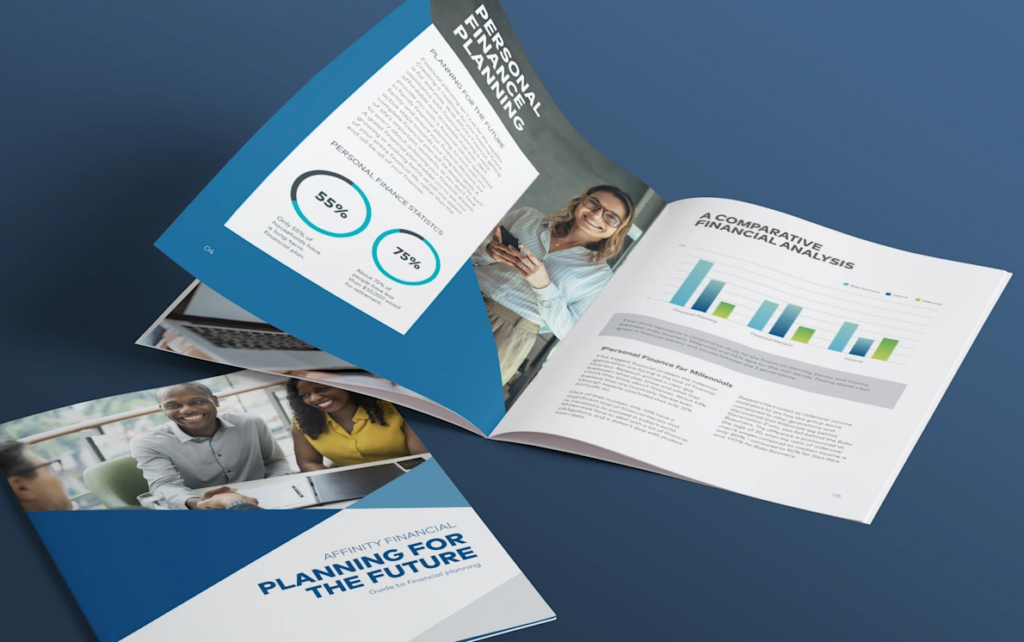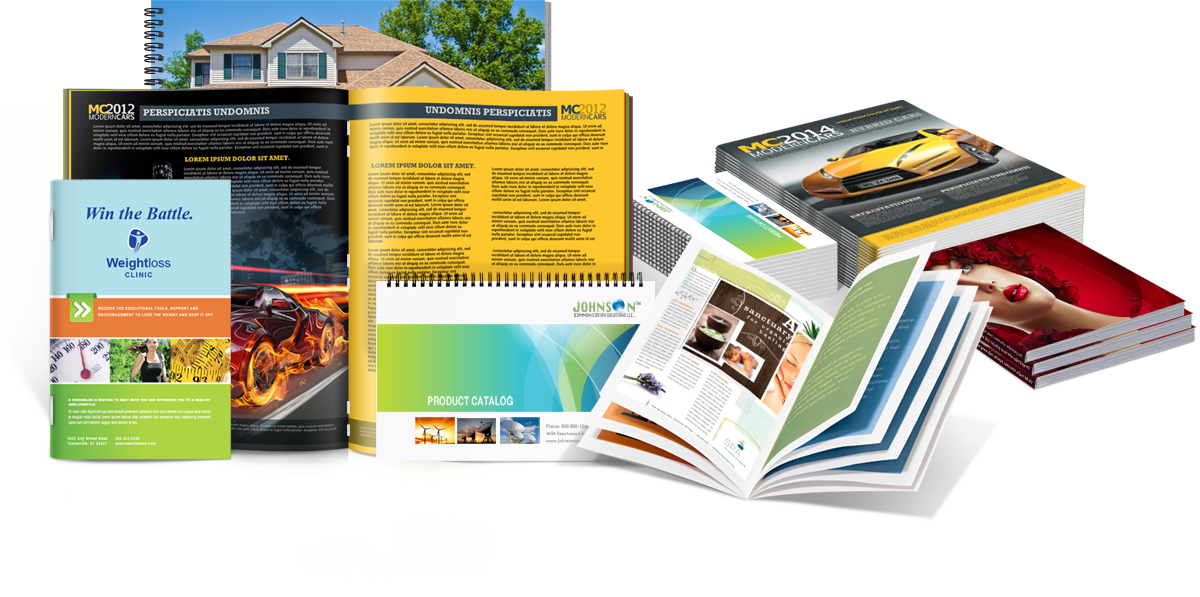Unlock the Power of Augmented Reality in Your Booklet Printing Projects
Unlock the Power of Augmented Reality in Your Booklet Printing Projects
Blog Article
The Important Guide to Recognizing Brochure Printing Options and Techniques
The procedure of pamphlet printing entails numerous factors to consider that can significantly impact the end product. From selecting the ideal format and size to comprehending the nuances of binding techniques, each choice plays a crucial function. In addition, aspects such as paper stock and printing methods more affect the efficiency of the booklet. As one navigates these choices, it ends up being critical to grasp how they adjoin and what that means for the overall outcome.
Understanding Pamphlet Dimensions and formats
When considering booklet printing, recognizing the different styles and sizes offered is essential for achieving the wanted discussion. Brochures can be produced in many formats, consisting of saddle-stitched, spiral-bound, and perfect-bound, each offering distinctive benefits. Usual sizes range from conventional letter (8.5 x 11 inches) to smaller sized options like A5 (5.8 x 8.3 inches), enabling for versatility based on material and target audience.Selecting the ideal size can affect both the format and viewers engagement. Bigger dimensions might fit visually driven web content, while smaller formats may be extra portable and user-friendly. Furthermore, the number of pages affects the selection of binding method, as thicker brochures might call for stronger bindings. Ultimately, comprehending these elements permits for a more customized technique, making sure that the end product lines up with the designated message and visual, enhancing the general performance of the interaction.
Picking the Right Paper Supply

Binding Methods: Choices and Considerations
When it involves binding methods for booklets, a number of alternatives are offered, each with distinctive benefits. Saddle stitch binding offers an economical remedy for thinner brochures, while excellent binding techniques give an even more sleek look for thicker publications. Wire-O binding attracts attention for its sturdiness and convenience of usage, making it suitable for files that need adaptability.
Saddle Stitch Binding
Saddle stitch binding supplies a economical and useful remedy for constructing brochures, making it a preferred option amongst authors and businesses. This binding approach involves folding sheets of paper in half and stapling them along the fold line, producing a well organized and neat appearance. Normally appropriate for brochures with a lower page count, saddle sewing is ideal for magazines, brochures, and instructional products. The simpleness of this method enables fast manufacturing and is typically favored for marketing items or brief runs. Nevertheless, it is important to keep in mind that saddle stitch binding might not be ideal for thicker brochures, as the spinal column may not stand up under boosted weight. On the whole, it stays a trusted option for numerous printing tasks.
Perfect Binding Techniques
Perfect binding is an extensively made use of technique that provides a expert and polished coating to brochures and magazines. This method entails gluing the pages together at the spinal column utilizing a solid adhesive, enabling for a tidy edge and the capacity to hold a larger number of web pages compared to saddle stitching. Perfect binding is specifically appropriate for thicker brochures, such as brochures and annual reports, where a strong, level spinal column is wanted. Additionally, it offers the choice for a printed cover that can be designed to enhance visual charm. Considerations such as page matter, paper weight, and the intended usage of the booklet should be taken into account, as they can influence longevity and general quality.
Wire-O Binding Alternatives
Wire-O binding, recognized for its longevity and versatility, offers an excellent option for booklets that require easy web page transforming and a professional look. This binding method utilizes a series of steel loops that hold web pages safely, permitting them to exist flat when open. It is especially ideal for handbooks, catalogs, and discussions due to its durable nature. Wire-O binding is readily available in different shades and sizes, accommodating different web page counts and thicknesses. Additionally, it permits the addition of covers and tabs, enhancing the brochure's overall aesthetic. Factors to consider for Wire-O binding consist of the selection of cable shade, the dimension of the loopholes, and the level of modification wanted, all of which can exceptionally influence the last item's appearance and capability.
Digital vs. Offset Printing: Which Is Best for You?
When choosing a printing technique for pamphlets, comprehending the distinctions between digital and counter printing is crucial. Digital printing utilizes modern-day technology to create high-quality prints quickly and economically, making it ideal for brief runs or projects requiring fast turnaround times. It permits modification, supplying the capability to print on-demand with marginal waste.In contrast, balance out printing is a standard approach that succeeds in producing big amounts with consistent high quality. It involves transferring ink from a plate to a rubber blanket, then to the paper, which leads to precise information and lively shades. Nonetheless, balance out printing normally needs longer configuration times and is more affordable for larger volumes.Ultimately, the choice in between electronic and balance out printing relies on project requirements, spending plan, and wanted amount. For tiny, time-sensitive jobs, digital may be the very best selection, while countered might be preferable for bigger, high-grade manufacturings.

Creating Your Booklet: Tips and Finest Practices
When designing a booklet, mindful focus to format, typeface option, and shade usage can greatly boost its performance. A well-structured design overviews the viewers's eye, while appropriate typefaces guarantee readability and communicate the preferred tone. Additionally, effective use shade can stimulate feelings and highlight vital details, making the overall layout more impactful.
Selecting the Right Layout
Just how can one efficiently choose the ideal format for a brochure? It is vital to examine the booklet's objective and target audience. A clean, arranged design improves readability and involvement. Using a grid system can help in straightening components consistently, creating a professional appearance. Additionally, including aesthetic hierarchy through varying dimensions and placements of photos and text can guide the reader's eye and emphasize vital info. It is additionally vital to leave sufficient white room, which prevents overcrowding and enables for much better focus. Testing various designs through mock-ups can supply insight right into just how the design does in real-world circumstances, guaranteeing that the final product fulfills both functional and aesthetic demands. Useful Selecting Proper Fonts
A well-chosen font style can substantially enhance my review here the overall style of a brochure, matching the layout and enhancing the content's message. The selection of typefaces should think about readability, specifically for body message, as it assures the information is easily accessible to all readers. Sans-serif fonts are usually chosen for electronic styles, while serif fonts can provide a standard feel in published materials. It's advisable to restrict font choices to 2 or 3 to maintain visual comprehensibility. Furthermore, font style size plays a crucial role; headings must be distinctive yet not frustrating, while body text should be comfy for reading. When picking font styles, positioning with the brochure's motif and target market is crucial for effective communication and visual appeal.
Effective Use of Shade
Shade works as an effective device in booklet layout, guiding and shaping assumptions visitor emotions. It can stimulate feelings of count on, enjoyment, or peace, depending on the shades picked. Designers should consider shade concept concepts, making certain that the selected scheme straightens with the booklet's message and target market. Utilizing warm shades like red and orange can create seriousness, while cooler tones like green and blue foster tranquility.Additionally, contrast plays an important role; complementary colors can improve readability and aesthetic charm. Uniformity in color use across pages additionally reinforces brand name identification and cohesion. Ultimately, effective shade execution not just captures focus yet likewise enhances the booklet's function, making it a necessary aspect of effective style.
Ending Up Touches: Coatings and Special Impacts
While several take into consideration the content and format of a pamphlet the most crucial components, the ending up touches, such as layers and unique impacts, play a crucial role in enhancing its overall appeal. Coatings can supply defense and durability, making certain that the booklet endures deterioration. Matte coatings provide an innovative, non-reflective surface area, while glossy layers can make shades show up more vivid and distinctive. Unique results, like embossing or foil stamping, include a tactile measurement that can produce an unforgettable impact. These techniques can highlight particular locations, attracting interest to essential information or creating visual interest. Furthermore, UV layer can give a high-shine coating that elevates the overall look.Together, these completing touches not only boost the pamphlet's visual but likewise communicate professionalism and reliability and attention to detail, eventually leaving a lasting influence on the reader.
Cost Factors To Consider for Booklet Printing
Recognizing the different expense considerations for brochure printing is essential for organizations and companies aiming to enhance their budgets. Key variables influencing expenses include the selection of ink, paper, and binding methods. Better materials, such as premium paper or specialized inks, usually enhance the overall expense. Furthermore, the size and web page count of the brochure play a considerable function; larger brochures call for more resources and time to produce.Another essential consideration is the printing method, whether electronic or balanced out, as each has its own prices structure and suitability for different quantities. Services ought to also consider design expenses, which can differ based upon intricacy and using expert services. Eventually, delivery and handling costs can include to the overall, especially for large orders. By assessing these elements, companies can make educated decisions that line up with their financial capabilities while attaining the wanted top quality in their published products.
Often Asked Concerns
What Are the Ecological Influences of Booklet Printing?
The ecological influences of pamphlet printing consist of deforestation from paper production, carbon exhausts from transport, and waste generation from disposed of products - Booklet Printing. Lasting methods, such as utilizing recycled paper and green inks, can reduce these impacts
Just How Can I Ensure Shade Accuracy in My Booklet?
To ensure shade precision in a booklet, one must utilize this page adjusted screens, use specialist shade accounts, perform examination prints, and select top notch printing services that provide shade matching and proofing alternatives for finest outcomes.
What Is the Normal Turnaround Time for Brochure Printing?
The regular turn-around time for brochure printing differs depending on the complexity and quantity - Booklet Printing. Typically, it varies from a couple of days to 2 weeks, affected by elements such as publishing approaches and completing needs
Exist Minimum Order Quantities for Pamphlet Printing?

Can I Print Booklets in Multiple Languages?
Publishing booklets in numerous languages is possible. Numerous printing solutions use choices for bilingual or multilingual designs, enabling reliable communication. Cautious preparation warranties that develop aspects suit various languages without jeopardizing readability or visual appeals. In addition, aspects such as paper supply and printing techniques further affect the performance of the pamphlet. When thinking about booklet printing, understanding the various layouts and dimensions offered is essential for accomplishing the wanted presentation. When picking a printing method for pamphlets, recognizing the distinctions in between digital and counter printing is necessary. In addition, the dimension and page matter of the pamphlet play a significant role; bigger brochures require more sources and time to produce.Another vital consideration is the printing method, whether electronic or offset, as each has its own rates structure and suitability for different amounts. The ecological effects of brochure printing include logging from paper production, carbon discharges from transport, and waste generation from thrown out materials.
Report this page